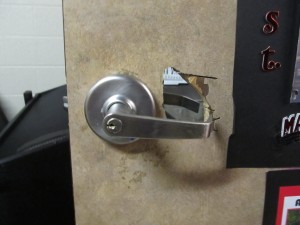
This photo was taken during one of our school hazard and vulnerability assessments. A staff member locked their keys in the band room and cut this hole in the door to unlock the door. This would not only make it easy for someone to steal expensive musical instruments, but makes an excellent safe room easy for an aggressor to enter.
School Hazard and Vulnerability Assessments – Screening Vendors
I apologize for the recent lack of blogs. I have been conducting school hazard and vulnerability assessments for three straight weeks in Washington D.C, Richmond, Virginia and Ketchikan, Alaska. With our other projects and the book release, I have not had time to post.
Each of the assessment projects involved a very competitive bid process with careful screening of vendors and have gone very well. At the same time, school safety assessment projects can go awry if the vendor and the hiring organization are not a good fit for one another. This can happen even with the best school security firms and great school systems and non-public schools. Fortunately, it can be relatively easy to screen vendors to find a good fit for school hazard ability assessment projects.
Finding a good fit for your school security project
The most common complaints I hear from school officials who have been dissatisfied with a school hazard and vulnerability assessment project are similar to those I often see in the school safety malpractice civil actions I work as an expert witness. In both types of situations, problems with school hazard and vulnerability assessment projects usually stem from an inadequate screening of vendors. There are ways school officials can identify firms that are a good fit. These approaches also minimize exposure to school safety litigation:
Require at least a dozen references
Any firm that is qualified to perform school security assessments should be able to provide dozens of references from K12 school organizations. We recommend that at least six references be checked and checking all twelve is an excellent idea.
Require a strategic report as well as a written report for each assessed school
For public school systems, a report which provides a comprehensive overview of opportunities for improvement as well as positive findings for the district is far more helpful than reports for each school and support facility alone. A detailed report of each school can also be very helpful for public school districts.
Require detailed and comprehensive reports
While busy educators naturally want concise reports, a ten to fifteen page report will likely serve as “exhibit A” when a school or consulting firm is litigated after an incident. This is because a properly conducted assessment will require far more information than can be fit in such a short space. Though an executive summary of five to ten pages is typical for a solid evaluation, a proper strategic report will normally consist of fifty to one hundred and fifty pages of data, photographs, and narrative content. Individual school reports should typically range between thirty to fifty pages per school.
Require a draft report and an opportunity to fact-check reports before they are finalized
There have been horror stories of school officials who have been stuck with bad school security assessment reports. Just as the hiring attorney in a federal civil action typically fact-checks an expert witnesses report before it is finalized, school officials should not take chances with consultants who are not open to fact-checking of their reports.
These basic requirements can go a long way to help you select the best firm for your situation. The time it takes to properly vet school security firms is considerably less than the time required to fix a mess created by a poorly performed hazard and vulnerability assessment process.